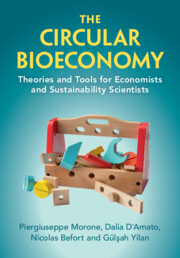Book contents
- The Circular Bioeconomy
- The Circular Bioeconomy
- Copyright page
- Contents
- Figures
- Tables
- Preface
- Acknowledgements
- Note on the Text
- Abbreviations and Notations
- Part I
- Part II
- Part III
- 7 LCA, LCC, and S-LCA Applied to the Bioeconomy
- 8 Innovation Systems and Global Value Chains in the Bioeconomy
- 9 Monitoring Progress towards a Sustainable and Just Bioeconomy
- Index
- References
9 - Monitoring Progress towards a Sustainable and Just Bioeconomy
from Part III
Published online by Cambridge University Press: 26 October 2023
- The Circular Bioeconomy
- The Circular Bioeconomy
- Copyright page
- Contents
- Figures
- Tables
- Preface
- Acknowledgements
- Note on the Text
- Abbreviations and Notations
- Part I
- Part II
- Part III
- 7 LCA, LCC, and S-LCA Applied to the Bioeconomy
- 8 Innovation Systems and Global Value Chains in the Bioeconomy
- 9 Monitoring Progress towards a Sustainable and Just Bioeconomy
- Index
- References
Summary
This chapter examines the tools and metrics available or under development to measure progress towards a biodiverse and circular bioeconomy. A broader discussion is also articulated about the need for monitoring systems towards a sustainable and just economy and society.
Keywords
- Type
- Chapter
- Information
- The Circular BioeconomyTheories and Tools for Economists and Sustainability Scientists, pp. 166 - 177Publisher: Cambridge University PressPrint publication year: 2023



